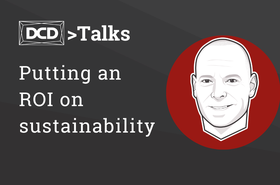With AI workloads skyrocketing and sustainability gaining increasing attention, data center operators are being forced to rethink how and where they build. In this episode of DCD>Talks, Stefan Nilsson, chief commercial officer at Conapto, chats with DCD about the sustainability challenges facing the data center industry, as it scrambles to keep pace with the AI boom.
With almost 30 years in IT and one of the first members of the Conapto team, Nilsson brings a sharp industry perspective about where he thinks things are heading.
The scale of AI
AI is no longer a niche technology – it is becoming foundational. However, the infrastructure needed to support it is unlike anything the industry has faced before. Kicking off the conversation, Nilsson is clear about the central issue in the current build-out for AI:
“The pure scale of everything that’s happening right now is probably the biggest challenge,” he says, adding: “The larger the deployments, the harder it is to do something truly sustainable with them.”
While the industry is racing to meet demand, it must avoid becoming a burden to the communities it moves into, avoiding the ‘not in my backyard’ mentality that may be perceived when a data center makes itself purely a consumer, rather than a contributor.
Turning waste into value
So, what’s Conapto doing differently? Quite a lot, actually.
In Stockholm, all four of Conapto’s data centers are directly connected to the city’s district heating network. But this isn’t low-grade heat reuse, as Nilsson explains:
“We’re actually doing high heat reuse, which means we’re seen as a legitimate heat source in the network. They can phase out less sustainable sources and use us instead. That’s a win for everyone.”
Conapto is also using its lithium-ion battery systems to support Sweden’s national grid – an initiative that extends its impact well beyond just environmental benefits. With three megawatts already in place and plans to add six more, Nilsson says the goal is to deliver 10 percent of the ~100 megawatts of balancing capacity the Swedish grid requires:
“It’s not just sustainable – it’s a real contribution,” says Nilsson, adding:
“Because of the partnerships we’ve built, we’re now in a situation where district heating providers are actually helping us find land for future sites. That’s what happens when you’re seen as a benefit to the community, not a burden.”
Rethinking ROI
As the conversation shifts to the business case for sustainability, Nilsson makes a key point: the bigger the facility, the harder it is to do anything meaningful with the waste it generates:
“You won’t find a municipality that can absorb the heat from a 500-megawatt AI center. That’s just reality.”
Instead, he encourages the industry to think more strategically, noting that while large-scale AI training needs huge capacity, we also need to plan for impact and ROI beyond just compute:
“Maybe we build a little smaller. Maybe we choose locations that are better connected to local infrastructure. Are we actually using green electricity, or just buying PPAs to make it look that way on paper? Are we reusing what we can? Is our sustainability strategy something we can prove, or just talk about?”
The next frontier
This shift in thinking opens up new questions about sustainability, infrastructure design, and local integration, with Nilsson giving us a glimpse into where the industry is heading next – and it’s not just bigger:
“The next wave of AI is about bringing it closer to where it’s needed – at the enterprise level, in real-time applications,” he says. “So far, it’s been 90 percent about training huge models in massive data centers. But now we’re shifting to 90 percent inference and Edge deployments.”
Watch the full episode of DCD>Talks with Stefan Nilsson of Conapto here.
More from Conapto

Sponsored
Can AI deployments be part of the circular economy?
The different ways that heat reuse can be implemented to become a core part of your sustainability strategy


Sponsored
Grid balancing: Yet another great contribution from a data center
How data centers can balance increasing power demand and intermittent renewables, advancing decarbonization and sustainability goals
Read the orginal article: https://www.datacenterdynamics.com/en/marketwatch/time-to-rethink-scale-strategy-and-roi/



